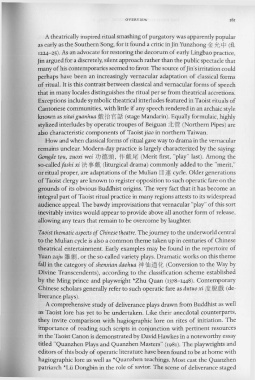Page 221 - The Encyclopedia of Taoism v1_A-L
P. 221
OVERVI EW 181
A theatrically inspired ritual smashing of purgatory was apparently popular
as early as the Southern Song, for it found a critic inJin Yunzhong ~ it if1 (ft.
1224- 25). As an advocate for restoring the decorum of early Lingbao practice,
Jin argued for a discretely, silent approach rather than the public spectacle that
many of his contemporaries seemed to favor. The source of Jin's irritation could
perhaps have been an increasingly vernacular adaptation of classical forms
of ritual. It is this contrast between classical and vernacular forms of speech
th~t in many locales distinguishes the ritual per se from theatrical accretions.
Exceptions include symbolic theatrical interludes featured in Taoist rituals of
Cantonese communities, with little if any speech rendered in an archaic style
known as xitai guanhua ~ ti:! '§ tffi (stage Mandarin). Equally formulaic, highly
stylized interludes by operatic troupes of Beiguan ~t ~ (Northern Pipes) are
also characteristic components of Taoist jiao in northern Taiwan.
How and when classical forms of ritual gave way to drama in the vernacular
remains unclear. Modern-day practice is largely characterized by the saying:
Gongde tou, zuoxi wei ~~RJ!, fl'lIt~ (Merit first, "play" last). Among the
so-calledfashi xi 1~~:r.~ (liturgical drama) commonly added to the "merit,"
or ritual proper, are adaptations of the Mulian § J! cycle. Older generations
of Taoist clergy are known to register opposition to such operatic fare on the
grounds of its obvious Buddhist origins. The very fact that it has become an
integral part of Taoist ritual practice in many regions attests to its widespread
audience appeal. The bawdy improvisations that vernacular "play" of this sort
inevitably invites would appear to provide above all another form of release,
allowing any tears that remain to be overcome by laughter.
Taoist thematic aspects of Chinese theatre. The journey to the underworld central
to the Mulian cycle is also a common theme taken up in centuries of Chinese
theatrical entertainment. Early examples may be found in the repertoire of
Yuan zaju ~Iu , or the so-called variety plays. Dramatic works on this theme
fall in the category of shenxian daohua ;fE!lfw J!! ft (Conversion to the Way by
Divine Transcendents), according to the classification scheme established
by the Ming prince and playwright *Zhu Quan (1378- 1448). Contemporary
Chinese scholars generally refer to such operatic fare as dutuo xi ~Jm.rIIX (de-
liverance plays).
A comprehensive study of deliverance plays drawn from Buddhist as well
as Taoist lore has yet to be undertaken. Like their anecdotal counterparts,
they invite comparison with hagiographic lore on rites of initiation. The
importance of reading such scripts in conjunction with pertinent resources
in the Taoist Canon is demonstrated by David Hawkes in a noteworthy essay
titled "Quanzhen Plays and Quanzhen Masters" (198r). The playwrights and
editors of this body of operatic literature have been found to be at home with
hagiographic lore as well as *Quanzhen teachings. Most cast the Quanzhen
patriarch *Lti Dongbin in the role of savior. The scene of deliverance staged

